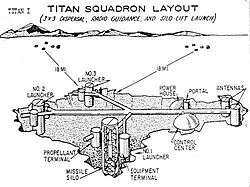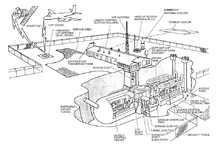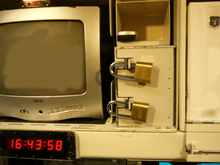Missile launch control center

A launch control center (LCC), in the United States, is the main control facility for intercontinental ballistic missiles (ICBMs). A launch control center monitors and controls missile launch facilities. From a launch control center, the missile combat crew can monitor the complex, launch the missile, or relax in the living quarters (depending on the ICBM system). The LCC is designed to provide maximum protection for the missile combat crew and equipment vital to missile launch. Missile silos are common across the midwestern United States, and over 450 missiles remain in US Air Force (USAF) service.
Due to modern conventional weapons, missile launch control centers are becoming more rare in the US, and it is expected that the number of missiles will lower to around 450 Minuteman 3. However, the USAF remains alert to any outbound threats and is prepared to launch their missiles in the event of nuclear war.
General information
All LCCs were dependent on a missile support base (MSB) for logistics support. For example, Minot AFB is the MSB for the 91st Missile Wing. This is important to note, for some wayward maintenance crews have unwittingly strayed from their MSB/missile complex, into another base's complex.
Three types of Minuteman LCCs exist:
- Alternate Command Post (ACP): performed backup functions to missile support base; control missile wing communications
- Squadron Command Post (SCP): perform backup functions to ACP; control squadron execution and communications
- Primary LCC (PLCC): perform execution and rapid message processing
There are four configurations of the LCC, differing primarily in the amount and location of communications equipment. Functionally, there are three LCC designations. One Alternate Command Post (ACP) LCC is located within each Minuteman wing and serves as backup for the wing command post. Three Squadron Command Posts (SCPS) serve as command units for the remaining squadrons within the wing, and report directly to the wing command post. The ACP doubles as SCP for the squadron it is located within. The remainder of the LCCS (16) are classified as primary LCCS. Four primary LCCS are located within each squadron and report to their respective command post.
Titan I LCC

Titan II LCC
The Titan LCCs held four crew members: the Missile Combat Crew Commander (MCCC), the Deputy Missile Combat Crew Commander (DMCCC), Ballistic Missile Analyst Technician (BMAT), and the Missile Facilities Technician (MFT).
Titan II had a three story LCC dome. The first level was the crews living area and contained a kitchen, bathroom, bedroom, and a small equipment area that housed an exhaust fan and a water heater. The second level was the launch control area and held the LCCFC (Launch Control Complex Facility Console, the main launch console), the ALOC (Alternate Launch Officer Console), the Control Monitor Group (monitored the missile), and several other pieces of equipment. The lowest level, level 3, held communications equipment, the two battery backup supplies, the sewage lift station, the motor-generator, and several other pieces of equipment.
There were two types of Titan II sites: standard, and ACP (alternate command post) sites. ACPs had all of the equipment that one would find on a standard site plus additional communication equipment.
Minuteman facilities
Launch Control Center
The LCC is an underground structure of reinforced concrete and steel of sufficient strength to withstand weapon effects. It contains equipment and personnel capable of controlling, monitoring, and launching 50 missiles in the unmanned launch facilities within the squadron.
The LCC outer structure is cylindrical with hemispherical ends. Walls are approximately 4.5 feet thick. A blast door permits entry into the LCC from the tunnel junction. An escape hatch 3-ft in diameter is located at the far end of the LCC. The escape hatch and associate tunnel are constructed to withstand weapon effects and allow personnel egress in the event of damage to the vertical access shaft (but the tunnel is sand-filled, which sand will flood the LCC if the hatch at the bottom of the tunnel is opened). Essential LCC launch equipment along with the missile combat crew are located in a shock isolated room suspended within the blast−proof outer structure. The room is steel and suspended as a pendulum by four shock isolators (see picture below).
REACT-B LCCs


CDB LCCs
Command-data Buffer (CDB) was a configuration for early Minuteman missiles. The overall layout of the LCC did not change through the upgrade to REACT, however there are some major equipment changes.
Missile Alert Facility
The Missile Alert Facility (MAF), previously known as the Launch Control Facility (LCF), consists of
Netlink
As of 2006, all Minuteman LCCs were modified to handle the LCC Netlink upgrade. The Netlink system brought internet access underground for missile combat crews.[1]
Communications equipment
- Primary Alerting System (PAS)
- Strategic Automated Command and Control System (SACCS) - formerly known as Strategic Air Command Digital Information Network (SACDIN)
- Minimum Essential Emergency Communications Network (MEECN) [2]
- Air Force Satellite Communications (AFSATCOM), using both Milstar and Defense Satellite Communications System satellites
- Survivable Low Frequency Communications System (SLFCS)
- Hardened Intersite Cable System lines (HICS)
- Voice Dial Lines 1 & 2
The Minuteman LCC differs from previous missile systems in that it only held room for two personnel, the Missile Combat Crew Commander (MCCC) and the Deputy Missile Combat Crew Commander (DMCCC).
Previously, each MAF was equipped with the ICBM SHF Satellite Terminal (ISST) communications system. This system has since been deactivated, with Francis E. Warren Air Force Base being the first to completely remove the system components.
Peacekeeper LCC
The Peacekeeper LCCs were non-REACT modified CDB LCCs. Instead of replacing the command and control equipment, the 'old' Minuteman CDB C2 system was modified for the 50 Peacekeeper ICBMs.
Photo gallery
-

LCC Blast Door
-

Launch Control Equipment Building Blast Door
-

Sealed Authenticator System safe with two crew locks
-

Art work at Foxtrot-01 LCC
-

Art work at Hotel-01 LCC
-

Blast Door Pins
-

Command Data Buffer configuration
See also
- Missile combat crew
- Post Attack Command and Control System (PACCS)
- Airborne Launch Control System (ALCS)
- Airborne Launch Control Center (ALCC)
- Survivable Low Frequency Communications System (SLFCS)
- Ground Wave Emergency Network (GWEN)
- Minimum Essential Emergency Communications Network (MEECN)
- Emergency Rocket Communications System (ERCS)
- The Cold War
- Game theory
- Continuity of government
References
- ↑ ""LCC Netlink", High Frontier Journal" (PDF). Afspc.af.mil. Retrieved 9 December 2014.
- ↑ "Product center completes $250 million program". Afmc.af.mil. Retrieved 9 December 2014.
External links
- U.S. National Park Service article with detailed information on Minuteman missile launch control centers.
- Titan Missile Museum: Pima Air & Space Museum
- 20th Century Castles: LCC real estate sales